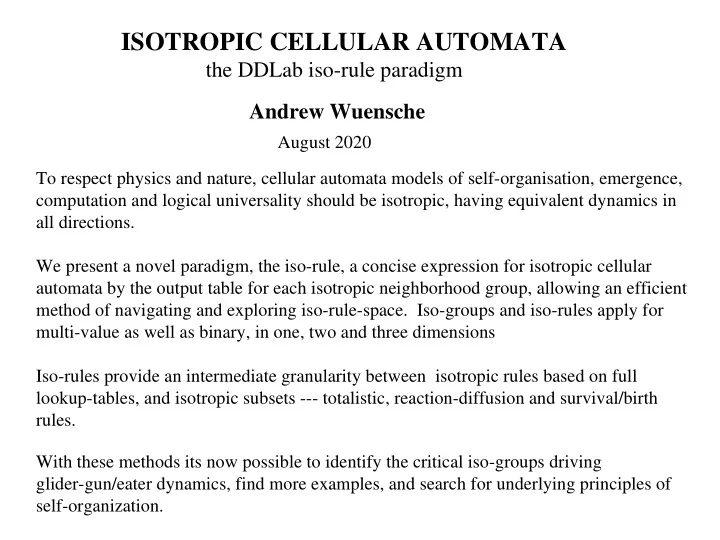

ISOTROPIC CELLULAR AUTOMATA the DDLab iso-rule paradigm Andrew Wuensche August 2020 To respect physics and nature, cellular automata models of self-organisation, emergence, computation and logical universality should be isotropic, having equivalent dynamics in all directions. We present a novel paradigm, the iso-rule, a concise expression for isotropic cellular automata by the output table for each isotropic neighborhood group, allowing an efficient method of navigating and exploring iso-rule-space. Iso-groups and iso-rules apply for multi-value as well as binary, in one, two and three dimensions Iso-rules provide an intermediate granularity between isotropic rules based on full lookup-tables, and isotropic subsets --- totalistic, reaction-diffusion and survival/birth rules. With these methods its now possible to identify the critical iso-groups driving glider-gun/eater dynamics, find more examples, and search for underlying principles of self-organization.
iso-rules: initial symmetry must be preserved patterns from a singleton seed, v=4, 2d and 3d
iso-rules apply to 1d, 2d and 3d neighborhood templates, for binary v=2, and multi-value v>=3 v=value-range (number of colors) k=neighborhood size 2 1 0 1d … any neighborhood size, k 2d : k=3 to k=9, k=4 can be either hex or square 3d: k=6 or k=7 template geometry is chosen for best symmetry – target cell sometimes included
full lookup tables – complete list of v k neigborhoods – rcode follows template indexing – independent of template geometry Wolfram’s convention 2 5 =32 3 5 =243
isotropic subsets of rule types isotropic by default but can be re-expressed as rcode to transform to iso-rule totalistic rules tcode kcode outer-totalistic for binary: tcode=kcode reaction-diffusion survival/birth game-of-Life s23/b3 – rcode > iso-rule binary Moore template alternatives to iso-rule Hensel notation for Golly – DDLab compatible Emmauel Sapin’s notation from his publications
algorithm transforms full lookup-table to isotropic rcode (examples are majority rules) then rcode to iso-rule
the sizes of iso-rules for 2d and 3d are difficult to calculate analytically. The tables below give iso-rule sizes (number of iso-groups) computed algorithmically –- much shorter than rcode v k note: rcode sizes for... Moore 2d square 3d square cubic 2d hex v2k9 =102 v3k7 =171 v3k7=276 Game-of-Life Spiral rule Spiral rule
examples of iso-groups, represented by the left prototype
102 v2k9 2d iso-rule prototypes each represents an iso-group
276 v3k7 2d hex iso-rule prototypes each represents an iso-group
172 v3k7 3d iso-rule prototypes each represents an iso-group
iso-rule input-frequency histogram this and related functions are are present in DDLab for rcode, kcode, tcode -- now extended to iso-rules this example: v2k9 Sayab rule – emergent glider-gun the frequency of iso-rule lookups in a moving window of time-steps here w=100, but could w=1 high w stabilizes the histogram here the bars have been amplified here the histogram is toggled to log 2 frequency for better view of small/large bars – used in later slides entropy of the histogram (from the frequency plot) – (normalized 0-1) input-entropy
On-the-fly iso-rule progressive filter (high to low – black block) unfilter (low to high) v3k6 hex ( – 92 bars – emergent spirals
iso-rule interactive mutation on-the fly random mutations aim for unfiltered bars first – and restored in reverse order while watching the effects on space-time patterns in a sort of mutation game v3k7 spiral rule – hex lattice - emergent glider-guns
input-entropy and min-max variability game-of-Life from random 40x40 initial state, density=30% 250 time-steps, colors follow the iso-histogram. min-max is the biggest upslope ignoring initial (22) steps
automatically classifying iso-rule-space: scatter-plots find glider/eater iso-rules to construct glider-guns, (or find emergent glider-guns) for logically universal CA x=entropy-vatiability, y=nean-entropy, z=log 2 rule frequency
iso-rule scatter-plots, lattice 60x60, sample size=50000 sorted by min-max, then by mean entropy v2k9 v3k7
glider-gun review – very few -- E mergent core, L ogically universal, p =period v2k9 rules <Conway, Gosper> E v3k6 Beehive rule p =13 <Wuensche> E L L <Gomez Solo, Wuensche (Conway Life Forum)> E L L E L L L Xrule not fully isotropi c p =38 v3k7 Spiral rule <Adamatsky, Wuensche> p =6 p =8 E E Beehive rule p =6 <Wuensche> 2 types of glider-guns: constructed, and emergent by glider/object collisions. Located objects (eaters, reflectors, oscillators) are L required to make logical gates.
Discrete Dynamics Lab OPEN SOURCE Tools for researching Cellular Automata, Random Boolean Networks, multi-value Discrete Dynamical Networks, and beyond www . ddlab . org Language: plain C Platforms: Linux Mac Cygwin Dos space-time patterns basins of attraction
Recommend
More recommend